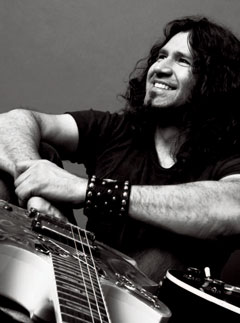


Phil X is one of those rare players that seem equally comfortable adding the perfect guitar hook to an American Idol track or rocking stadiums with monster riffs.
"Dude, I'm a chameleon!" says the Greek-born, Canadian-raised, Los Angeles-based axman. "The way I see it, my mission is to enhance the song. A song is supposed to take you on a journey during the verse and make that chorus climax. That's equally true whether I'm playing with Kelly Clarkson or Avril Lavigne. I'm very good at secondary parts that complement the vocals and each section of a song. I just have this instinct, and I keep getting called back."
But pop artists aren't the only ones calling-Phil has also worked with rockers Alice Cooper, Rod Zombie, and Tommy Lee. He replaced guitarist Rik Emmett in Triumph for the group's Edge of Excess album and tour, and he recently substituted for Richie Sambora on a string of U.S. dates with Bon Jovi.
"I had to do a lot of homework for that," says Phil, whose full last name is Xenidis. "I had to learn 30 songs really quickly. We rehearsed for about seven hours, and then I was out in front of 50,000 people. Nobody gave me much direction-right out of the gate everyone was saying, 'Hey, you're doing a great job!' So it was pretty cool!"

Phil studied DVDs of Sambora shows to determine whether to play a part note-for-note or add his own ideas. "If Richie nailed the solo from the record, I would too," he says. "If it was a song where he went off on an improvisational tangent, I would do that. But come on, dude - there's no way you can do another solo on a song like 'Dead or Alive' or 'Livin' on a Prayer.' It's gotta be that solo!"
Though Phil doesn't read music, it hasn't hindered his session career. "I always make a chart to get me through the song," he explains. "I never want to be the guy everyone's pointing to and saying, 'Phil's holding us up.' I can make charts fast, after one or two times through the song. That mostly comes from playing a thousand cover songs as a teenager. That's how I learned how chord progressions work and how melodies work over them. A strong ear makes you a better musician, a better session player, and someone artists want to have around when they're making a record."
Phil is also deeply involved in gear design. He invented the "flip stick," a whammy-bar replacement that mounts perpendicularly to the face of a guitar. He's one of the principals behind Evil Robot amps. He designs guitar pickups. And he recently collaborated with Yamaha on a Phil X signature model.
The jumping-off point for the new model is the classic SBG1802, a big, beefy double-cutaway model. SBG-series guitars are usually fitted with a pair of humbucking pickups, but Phil prefers the rougher, more primitive sound of a single-coil P-90 pickup. And since he usually plays using only the bridge pickup, his model features a single, hotter-than-vintage P-90 and a cavity where the neck pickup usually resides. In the past he's populated the hole with various toys and action figures, but his signature model features a fan grill (as well as a dummy pickup cover for players who prefer a traditional look).
If you're going to work that hard to learn somebody's solo, why not work even harder and take it to another level? Why not make it your own?
Why a single P-90? "It's about clarity," Phil replies. "I love a pickup that responds to my hands. Also, I love the thickness of the P-90-it doesn't thin out as you approach the higher frets, like Les Pauls with humbuckers do. When you go for a high note, it's nice and thick, but then you can hit a chord, and it's real clear-sounding. That's the same reason I don't use too much amp gain. If the drummer says to me after the show, 'Man, I heard every note you played tonight,' I know I did something right."
You can hear Phil's fretwork in scores of popular YouTube videos, including many he created for the rare-guitar dealer Fretted Americana. "YouTube is an incredible tool if used properly," says Phil. Yet he confesses that the sheer number of videos featuring note-for-note versions of famous solos frustrates him.
"All these kids go on and say 'Hey, this is my cover of Iron Maiden, this is my cover of Van Halen.' Everybody's copycatting up the wazoo. It makes me want to say, 'Fine, man, but where are your licks? Where are your tones? Where's your individuality? If you're going to work that hard to learn somebody's solo, why not work even harder and take it to another level? Why not make it your own?"
(Photography Credit: Rob Shanahan)
























